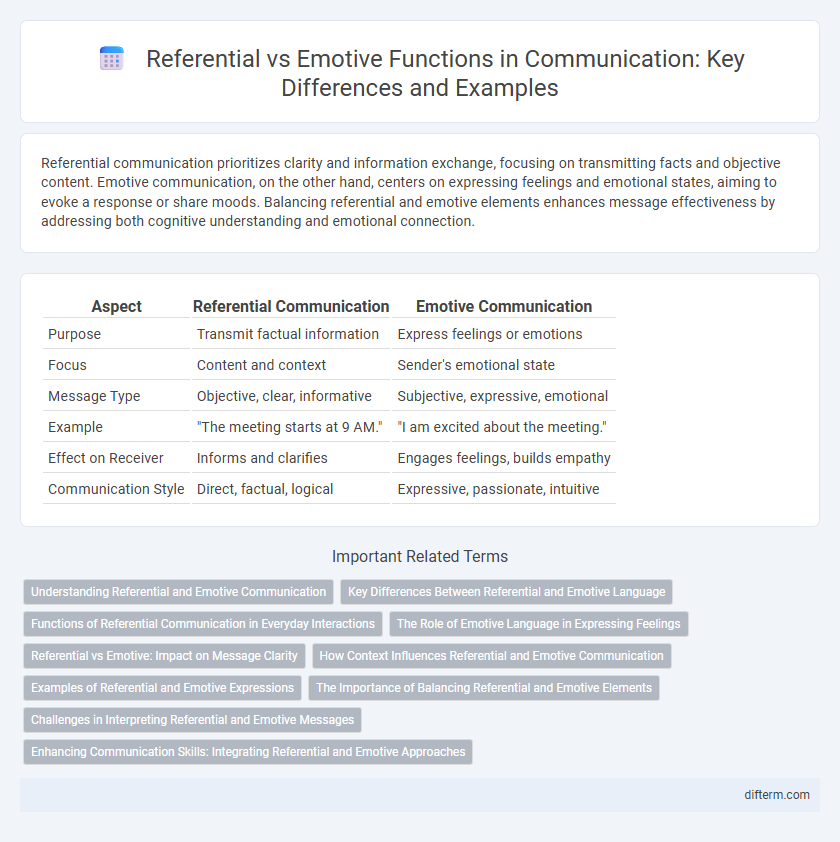Referential communication prioritizes clarity and information exchange, focusing on transmitting facts and objective content. Emotive communication, on the other hand, centers on expressing feelings and emotional states, aiming to evoke a response or share moods. Balancing referential and emotive elements enhances message effectiveness by addressing both cognitive understanding and emotional connection.
Table of Comparison
| Aspect | Referential Communication | Emotive Communication |
|---|---|---|
| Purpose | Transmit factual information | Express feelings or emotions |
| Focus | Content and context | Sender's emotional state |
| Message Type | Objective, clear, informative | Subjective, expressive, emotional |
| Example | "The meeting starts at 9 AM." | "I am excited about the meeting." |
| Effect on Receiver | Informs and clarifies | Engages feelings, builds empathy |
| Communication Style | Direct, factual, logical | Expressive, passionate, intuitive |
Understanding Referential and Emotive Communication
Referential communication conveys factual information aimed at clear understanding and knowledge transfer, using precise language to describe objects, events, or concepts. Emotive communication expresses the speaker's emotions, attitudes, or feelings, often employing tone, intonation, and subjective language to evoke emotional responses. Understanding the distinction between referential and emotive communication enhances effective message interpretation and interpersonal connection.
Key Differences Between Referential and Emotive Language
Referential language prioritizes clarity and factual accuracy to convey information objectively, using explicit data and concrete details. Emotive language, in contrast, appeals to the audience's emotions by employing subjective expressions, vivid imagery, and tone to evoke feelings and personal connections. Understanding the key differences helps in tailoring communication strategies for effective informational or persuasive outcomes.
Functions of Referential Communication in Everyday Interactions
Referential communication primarily functions to convey clear, objective information about the environment, ensuring shared understanding in everyday interactions. This function supports accurate knowledge transfer, problem-solving, and coordination through precise language and factual statements. Emphasizing referential content reduces ambiguity and enhances efficiency in tasks requiring specific, verifiable data exchange.
The Role of Emotive Language in Expressing Feelings
Emotive language plays a crucial role in communication by conveying feelings and evoking emotional responses in the audience, enhancing personal connection and engagement. Unlike referential language, which focuses on transmitting factual information, emotive language uses tone, connotation, and imagery to express subjective experiences and attitudes. Effective use of emotive language fosters empathy and deeper understanding by appealing directly to the listeners' or readers' emotions.
Referential vs Emotive: Impact on Message Clarity
Referential communication prioritizes clear, precise information delivery by focusing on objective facts and data, which enhances message clarity and reduces ambiguity. Emotive communication conveys feelings and attitudes, often adding emotional context that can influence the recipient's interpretation but may risk message distortion. Understanding the balance between referential and emotive elements is crucial for effective communication, ensuring messages are clear while engaging the audience emotionally.
How Context Influences Referential and Emotive Communication
Context shapes referential communication by grounding messages in specific situational details, ensuring clarity and precision in information exchange. Emotive communication is influenced by contextual factors such as social setting, emotional state, and cultural background, which alter the intensity and interpretation of feelings expressed. Understanding these contextual elements enhances effective communication by aligning message intent with audience perception.
Examples of Referential and Emotive Expressions
Referential expressions convey factual information, such as "The meeting starts at 10 AM" or "Water boils at 100 degrees Celsius," providing clear and objective content. Emotive expressions reveal the speaker's feelings or attitudes, for example, "I'm excited about the project" or "That experience was frustrating," adding personal emotional context. These distinctions enhance communication by balancing objective data with subjective emotional insights.
The Importance of Balancing Referential and Emotive Elements
Balancing referential and emotive elements enhances communication effectiveness by ensuring clarity while engaging the audience's emotions. Referential content provides precise information and factual accuracy, crucial for comprehension and decision-making. Emotive elements create connection and motivation, fostering trust and empathy that drive meaningful interactions.
Challenges in Interpreting Referential and Emotive Messages
Interpreting referential messages poses challenges due to their reliance on objective information, making context crucial for accurate understanding. Emotive messages complicate communication by expressing feelings that may be subjective and vary widely between individuals. Misinterpretations often arise when the receiver fails to distinguish between factual content and emotional undertones, leading to misunderstandings.
Enhancing Communication Skills: Integrating Referential and Emotive Approaches
Enhancing communication skills involves balancing referential and emotive approaches to convey clear information while expressing feelings effectively. Referential communication focuses on objective data and factual clarity, enabling precise understanding in professional or technical contexts. Emotive communication engages emotions and personal attitudes, fostering empathy and deeper connection in interpersonal interactions.
referential vs emotive Infographic

 difterm.com
difterm.com